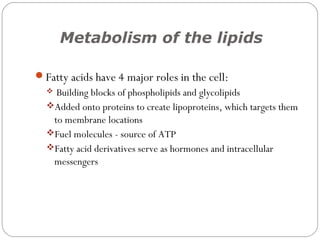
Ch04 b
- 1. Metabolism of the lipids Fatty acids have 4 major roles in the cell: Building blocks of phospholipids and glycolipids Added onto proteins to create lipoproteins, which targets them to membrane locations Fuel molecules - source of ATP Fatty acid derivatives serve as hormones and intracellular messengers
- 2. Omega-3 f.acids shown to slow the development of cardiovascular diseases
- 4. The oxidation of f.acids – source of energy in the catabolism of lipids Both triacylglycerols and phosphoacylglycerols have f.acids as part of their covalently bonded structures The bond between the f.acids and the rest of the molecule can be hydrolyzed (as shown in the fig.) Fig. 21-1, p.569
- 5. p.569
- 9. • Fatty acids oxidation begins with activation of the molecule. • A thioester bond is formed between carboxyl group of f.acid and the thiol group of coenzyme A (CoA-SH) (esterification reaction – in cytosol)
- 13. Fig. 21-5, p.571
- 21. When a f.acid with an even number of C atoms undergoes successive rounds of β-oxidation cycle, the product is acetyl- CoA. No. of molecules of acetyl-CoA produced = ½ the no. of C atoms in the original f.acid. (as shown in fig above) The acetyl-CoA enters the TCA cycle (the rest of oxidation to CO2 and H2O taking place via TCA cycle and ETC) β-oxidation takes place in mitochondria.
- 22. The oxidation of unsaturated f.acids does not generate as many ATPs as it would for a saturated f.acids (same C atoms) – the presence of double bond • the acyl-deH2ase step skipped – fewer FADH2 will be produced
- 25. The catabolism of odd-carbon f.acids
- 27. Ketone bodies Substances related to acetone (“ketone bodies”) are produced when an excess of acetyl-CoA arises from β- oxidation Occurs because when there are not enough OAA to react with acetyl-CoA in TCA cycle When organisms has a high intake of lipids and low intake of CHO or starvation and diabetes The reactions that result in ketone bodies start with the condensation of two molecules of acetyl-CoA to produce acetoacetyl-CoA
- 28. • the odor of acetone can be detected on the breath of diabetics whose not controlled by suitable treatment • Acetoacetate and β-hydroxybutyrate are acidic, their presence at high [ ] overwhelms the buffering capacity of the blood • to lowered the blood pH is dealt by excreting H+ into the urine, accompanied by excretion of Na +, K + and water → results in severe dehydration and diabetic coma • synthesis of ketone bodies in liver mitochondria • transport ketone bodies in the bloodstream; water soluble • other organs such as heart muscle and renal cortex can use ketone bodies (acetoacetate) as the preferred source of energy • even in brain, starvation conditions lead to the use of acetoacetate for energy
- 29. FATTY ACID SYNTHESIS The anabolic reaction takes place in cytosol Important features of pathway: Intermediates are bound to sulfhydral groups of acyl carrier protein (ACP); intermediates of β-oxidation are bonded to CoA Growing fatty acid chain is elongated by sequential addition of two- carbon units derived from acetyl CoA Reducing power comes from NADPH; oxidants in β-oxidation are NAD+ and FAD Elongation of fatty acid stops when palmitate (C 16) is formed; further elongation and insertion of double bonds carried out later by other enzymes
- 32. Pathway of palmitate synthesis from acetyl-CoA and malonyl-CoA The biosynthesis of f.acids involves the successive addition of two-carbon units to the growing chain. - Two of the three C atoms of the malonyl group of malonyl- CoA are added to the growing fatty-acid chain with each cycle of the biosynthetic reaction
- 35. This reaction require multienzyme complex : fatty acid synthase Fig. 21-15c, p.583
- 44. Lipids are transported throughout the body as lipoproteins Both transported in form of lipoprotein particles, which solubilize hydrophobic lipids and contain cell- targeting signals. Lipoproteins classified according to their densities: chylomicrons - contain dietary triacylglycerols chylomicron remnants - contain dietary cholesterol esters very low density lipoproteins (VLDLs) - transport endogenous triacylglycerols, which are hydrolyzed by lipoprotein lipase at capillary surface intermediate-density lipoproteins (IDL) - contain endogenous cholesterol esters, which are taken up by liver cells via receptor-mediated endocytosis and converted to LDLs low-density lipoproteins (LDL) - contain endogenous cholesterol esters, which are taken up by liver cells via receptor-mediated endocytosis; major carrier of cholesterol in blood; regulates de novo cholesterol synthesis at level of target cell high-density lipoproteins - contain endogenous cholesterol esters released from dying cells and membranes undergoing turnover
Hinweis der Redaktion
- FIGURE 21.1 The release of fatty acids for future use. The source of fatty acids can be a triacylglycerol (left) or a phospholipid such as phosphatidylcholine (right).
- FIGURE 21.3 Liberation of fatty acids from triacylglycerols in adipose tissue is hormone dependent.
- FIGURE 21.4 The formation of an acyl-CoA.
- FIGURE 21.5 The role of carnitine in the transfer of acyl groups to the mitochondrial matrix.
- FIGURE 21.7 Stearic acid (18 carbons) gives rise to nine 2-carbon units after eight cycles of -oxidation. The ninth 2-carbon unit remains esterified to CoA after eight cycles of -oxidation have removed eight successive two-carbon units, starting at the carboxyl end on the right. Thus, it takes only eight rounds of -oxidation to completely process an 18-carbon fatty acid to acetyl-CoA.
- FIGURE 21.11 The formation of ketone bodies, synthesized primarily in the liver.
- FIGURE 21.17 A portion of an animal cell, showing the sites of various aspects of fatty-acid metabolism. The cytosol is the site of fatty-acid anabolism. It is also the site of formation of acyl- CoA, which is transported to the mitochondrion for catabolism by the -oxidation process. Some chainlengthening reactions (beyond C16) take place in the mitochondria. Other chain-lengthening reactions take place in the endoplasmic reticulum (ER), as do reactions that introduce double bonds.
